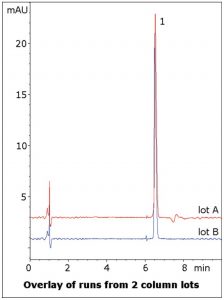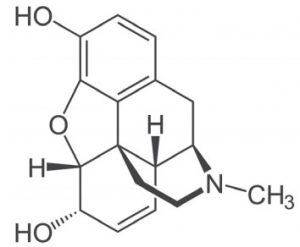Excellent Peak Shape for Tertiary Amine
Morphine can be a very problematic compound for analysis with HPLC. It has a tertiary amine and has a tendency to tail under some conditions. USP assay methodology uses phosphates, alkylsulfonates, or other LC-MS incompatible agents in the Mobile Phase.
This Method uses only Formic Acid and can be readily adapted for LCMS. As such, analysis of Morphine in blood samples can be achieved with excellent retention and peak shape.

 Peak:
Peak:
Morphine Sulfate
Method Conditions
Column: Cogent Diamond Hydride™, 4µm, 100Å
Catalog No.: 70000-7.5P
Dimensions: 4.6 x 75mm
Mobile Phase:
—A: DI Water / 0.1% Formic Acid (v/v)
—B: Acetonitrile / 0.1% Formic Acid (v/v)
Gradient:
| Time (minutes) | %B |
| 0 | 90 |
| 1 | 90 |
| 6 | 40 |
| 7 | 90 |
Post Time: 3 minutes
Injection vol.: 1µL
Flow rate: 1.0mL / minute
Detection: UV @ 284nm
Sample Preparation: 15mg strength Morphine Sulfate tablet was ground and weighed in a 25mL volumetric flask. A portion of 50:50 Solvent A / Solvent B diluent was added and the flask was sonicated 10 minutes. It was then diluted to mark and filtered with a 0.45µm Nylon Syringe Filter (MicroSolv Tech Corp.).
t0: 0.9 minutes
Note: Morphine is a highly potent opiate analgesic widely used in clinical applications to treat severe pain. However, tolerance and addiction develop rapidly with its use so it has potential for abuse as well. It is named after Morpheus, the Greek god of dreams.
Attachment
No 230 Morphine Sulfate Tablet Analyzed with HPLC pdf 0.3 Mb Download File


